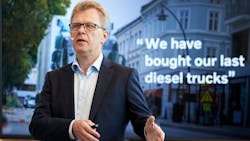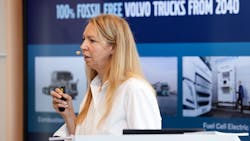Volvo sees BEV as the main path to cutting carbon from U.S. trucking
GOTHENBURG, Sweden—There are several paths to decarbonization, but Volvo Trucks believes batteries will have the most significant power in transforming the trucking industry in North America and globally. With six serial production electric trucks, it has sold more than 6,000 BEVs in 42 countries, about half the heavy-duty market share.
This head start in electric trucking will help Volvo and its fleet customers lead the industry in decarbonization, Volvo Trucks President Roger Alm told North American journalists at the Volvo Trucks headquarters here in Northern Europe, where the first Volvo cars and trucks were built nearly a century ago.
He noted that 7% of global CO2 emissions come from heavy-truck transportation. “Here, we have an impact—and we can help and make a change for many transport companies by changing this and reducing the CO2 coming from transport by selling our beautiful electrical trucks,” Alm said.
More than 1.2 million Volvo Trucks brands (Volvo, Mack Trucks, and Renault) operate in more than 150 countries. The company aims to have 50% of global truck sales be electric vehicles by 2030, and 100% be net-zero-emission vehicles by 2040.
Jessica Sandström, Volvo Trucks head of product management, said that if Volvo Trucks stops selling trucks that produce tailpipe emissions by 2040, the entire Volvo Trucks global population should reach net zero by 2050 through replacement cycles.
Alm also pointed out that the trucking industry is ahead of many other sectors looking to decarbonize. In North America, Volvo Trucks has an early market share lead after being the first major OEM to produce electric Class 8 trucks in the U.S.
But there is no one-size-fits-all answer for heavy-duty trucking, Sandström said. “We are a global company—so that means we need to find solutions for all our customers around the globe that operate in different climates, different segments, and different operating conditions,” she explained.
Fuel cell, ICE to complement BEV power
While it sees battery-electric trucks as the leading technology, Volvo has a three-path strategy toward net zero: BEVs, fuel-cell electric, and internal combustion engines.
The ICE powertrains of the future, which Volvo is developing, would run on fossil-free fuels, such as hydrogen, liquid natural gas, and renewable diesel. Hydrogen would also power fuel-cell trucks, one of which Volvo continues to test in Sweden. It is developing hydrogen fuel cell technology in a joint venture, Cellcentric, with rival Daimler Truck.
“To complement that, we see that the battery-electric trucks will be the main technology,” Sandström said. “That is the product we foresee will have the largest volume over time. It is because it’s simply the most efficient solution. But it also comes with a lot of other added values, like it is silent; it gives another dimension for many people interacting and driving the truck. On top of that, it’s extremely energy efficient. If we are going to be able to make this transformation from depending on fossil fuels into a fossil-free society, we need to make sure we save energy on the way.”
Essential paths to North American decarbonization
Along with three fossil-free truck powertrains by 2040, Sandstrom said there are three essential factors to decarbonize the North American trucking industry: investment in new technologies, development of charging and fueling infrastructure, and collaboration with customers, governments, and other stakeholders.
Sandström expects the battery technology to evolve, adding more range for heavy-duty trucking operations. But depending on fleet operations, she said the fuel cell would work better in some applications.
“As in many technology developments, there are pros and cons with different types of fuel,” Sandström explained. “For instance, I think we are learning and are trying to find the best trade-off by looking at the entire ecosystem. Because what could look best from a truck perspective is not necessarily what looks best when you take a step back, and you look at how you need to get the fuel to the fueling station.”
Volvo Trucks also believes that its BEV technology will continue to improve. “The battery-electric product we have today is not the end of that technology,” Alm said. “We will develop that over time.”
The success of each path to zero will also depend on how charging and refueling infrastructure is built in different parts of the world, Sandström noted. VTNA is working with several other companies to create electric truck charging corridors in California, stretching from the Long Beach area to north of the Bay Area. Volvo Group is also partnering with Pilot Co. to develop Class 8 electric truck charging infrastructure at Pilot travel centers in North America.
With Volvo’s investments in battery, fuel cell, and carbon-neutral internal combustion engines, Alm said Volvo Trucks cannot do it alone.
“We need to lean on strong cooperation with our customers,” he said. “We need to work tight with our customers to discuss with our customers how we can make this transformation happen… Of course, there are challenges as well to make the transformation—but if we don’t start, we will not handle it. We need to start—and we should have started yesterday.”
This story originally appeared on FleetOwner.com.
About the Author

Josh Fisher
Technology Editor
FleetOwner Editor-in-Chief Josh Fisher has been with Endeavor's Commercial Vehicle Group since 2017, covering everything from modern fleet management to operational efficiency, artificial intelligence, autonomous trucking, regulations, and emerging transportation technology. He is based in Maryland.


